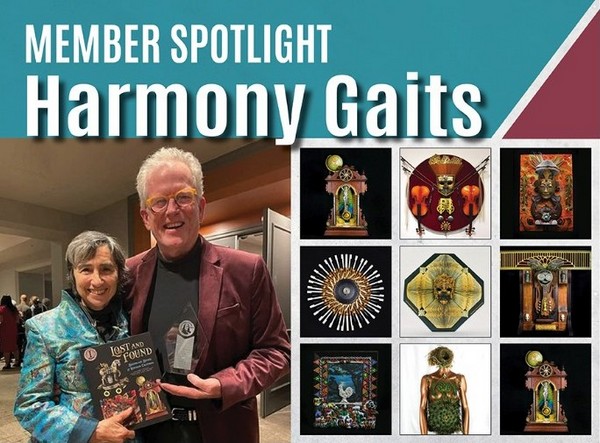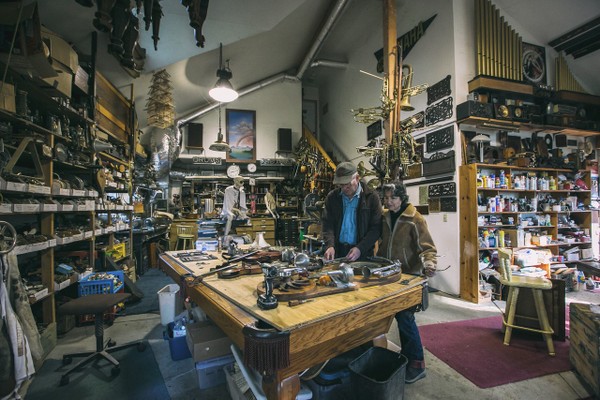
Sculpture Artists Produce Exquisite Book on Assemblage Artists
by Ashley Hiraeo
IBPA Association News
October 10, 2023
As assemblage artists, Esther Siegel and Spencer Brewer of Harmony Gaits are breathing new meaning into antique objects – they create unusual and one-of-a-kind sculptures out of repurposed and found items. Now their practice of assemblage art has launched them to new heights as both sculptors and publishers, after taking home an IBPA Benjamin Franklin Gold Award™ this year in the Interior Design category for their self-published book Lost and Found. Lost and Found is an delightful book which spotlights the extraordinary art of eight assemblage artists.
It’s not always easy to transform your passion into a practical business move, and finding the audience for such a niche book can be tricky. We sat down with Esther and Spencer to learn how they transformed their love for assemblage art into a lucrative publishing venture.
IBPA: You both are assemblage artists. For the benefit of those who don’t know much about this art form, please tell us more about this and the background of Harmony Gaits.
Spencer Brewer: Assemblage is the process of taking found objects and assembling them in ways that are different from their original intended purpose. Think ‘painting with objects.’ Sometimes the themes are humorous, sometimes very serious, and sometimes the objects are reassembled in ways that demonstrate their beauty from an unexpected angle.
Harmony Gaits is the name of our property, which has a barn for horseback riding, an art studio, and at one time a recording studio. It combines my love of music (Harmony) with Esther’s love of horses (Gaits).
IBPA: Both of you are artists in your own right—what led you to the publication of Lost and Found?
Esther Siegel: After searching nationally for books and publications on assemblage art, we discovered only a small handful were available. Some of these were published in the 1970s in black and white. The bulk of the books on this subject were instructional…how to make a finished assemblage art piece.
The few books that highlighted contemporary artists gave each artist one to two pages to display their pieces and themselves. We came to the conclusion that we should embark on the journey of creating an assemblage book of northern California artists ourselves. We envisioned a gallery style experience of at least 20-24 pages of artwork per artist which included their artist statement and inspirations. We also felt isolated and lacked connection with other assemblage artists regionally. Plus we wanted to showcase our own creations, so by putting the book together, a community was created. When everyone met for the first time, we found out that many artists were fans of each other’s work, which was inspiring and exciting.
IBPA: Tell us more about the process of getting it published.
Spencer: First we had to identify the artists who would be included in the book with us. It was during COVID, so searching and meeting each one was all online. Some of the artists referred us to other regional artists that we should investigate.
After deciding the number of artists to be included and picking the finalists, the next lengthy step was collecting all the possible photographs that existed for each artist. In many cases the quality of the photos were not book-worthy. The artists had input for inclusion, but we had the final say what would be included. This never created a problem along the way, as they were all thrilled to be a part of the project. We worked with each artist to assemble their descriptions, inspirations, and bios. One of the artists had a strong interest in the history of assemblage, which we included in the book.
IBPA: How long was the overall design process?
Esther: It took almost two years to complete the multiple edits, renditions, and design changes with our first designer Larry Wagner, who was also the photographer. Once the first design was ‘in the can’, we had 12 books printed by Blurb as samples. We used these books to help us and the artists review and create edits for the final round. They were expensive, but necessary for this type of book. With the new information and changes, we hired another design firm, DG Creative, to take it to the next. This process took another year for the redesign and edits to be implemented.
IBPA: Since it can be a bit of a gamble, how did you decide on the number of copies to initially print?
Spencer: We obtained quotes from different printers from one of our lead consultants, Cynthia Frank of Cypress House Press and picked Qualibre, who shopped it to various presses. We were lucky to have Michele Savoy, one of Qualibre’s representatives, live locally as she helped us walk through the process. We landed with Jostens for printing. Things like paper weight and type, binding, cover finish, size, margins, type of press (offset, etc.) were all new to us and she educated us on all of this and more. Deciding on the initial order number was challenging without knowing how many books would sell. We landed on 500 for the first pressing and held our breath.

IBPA: Did you have to find a balance between your passion for sculpture with the practicality—time and finances—of publishing a book?
Esther: We were able to continue to make our assemblage art and do our other work of being a psychotherapist, composer, musician, and piano technician. We both work out of the home and our art studio is also on the property, so in our free time, we would wander over and continue making art.
IBPA: As self-published authors, did you face challenges in terms of budget along the way?
Spencer: Because the process took 3 years, we were able to budget the money and spread the expenses out. As we now are engaging consultants for publicity, marketing, and sales support, we did not foresee that the amount of money required at this stage would probably equal or exceed the amount to create the book. Although we are somewhat competent in these areas, we don’t have the connections in the book world to really make a difference on a national level. Thus we have to hire out!
IBPA: Who is the audience for your book and how did you market and promote your book? Where is it being sold?
Esther: Our audience includes artists and wannabe artists, librarians, art teachers, people who think outside the box, lovers of art and creativity, airports, interior designers, gift stores, and hospital gift stores. It is being distributed by Brigham Distributing, Ingram, Baker and Taylor, Follett, etc. It is also available on Amazon. We have personally placed it in many local bookstores, galleries, and a museum in northern California. We currently are in the midst of hiring a company to do PR, sales, and marketing.
IBPA: Do you have any advice for artists looking to publish books about their works?
Spencer: Start the process for getting professional reviews way in advance, setting up the Amazon account (which can take weeks), searching for and vetting potential distributors, and securing publicist/marketing support 6 months before the book is scheduled for release. Once the book is in your hands, immediately submit to various book award competitions.